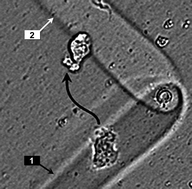Lab Chip 2010,10, 2139-46.
Dynamic Remodeling of Subcellular Chemical Gradients using a Multi-directional Flow Device.
Samira Moorjani, Rex Nielson, Xinming A. Chang, and Jason B. Shear
Elucidation of the mechanisms by which external chemical cues regulate polarized cellular behaviors requires tools that can rapidly recast chemical landscapes with subcellular resolution. Here, we describe an approach for creating steep microscopic gradients of cellular effectors at any desired position in culture that can be reoriented rapidly to evaluate dynamic responses. In this approach, micrometre pores are ablated in a membrane that supports cell adherence, allowing dosing reagent from an underlying reservoir to enter the cell-culture flow chamber as sharp streams that are directed at subcellular targets by using a system of paired sources and drains to specify flow direction. This tool substantially extends capabilities for chemical interaction with cultured cells, enabling investigations of chemotaxis via precise placement and reorientation of peptide gradients formed at the boundaries of dosing streams. These studies demonstrate that neutrophil precursor cells can repolarize and redirect their migration paths using morphological responses that depend on the subcellular localization of chemoattractant gradients.
